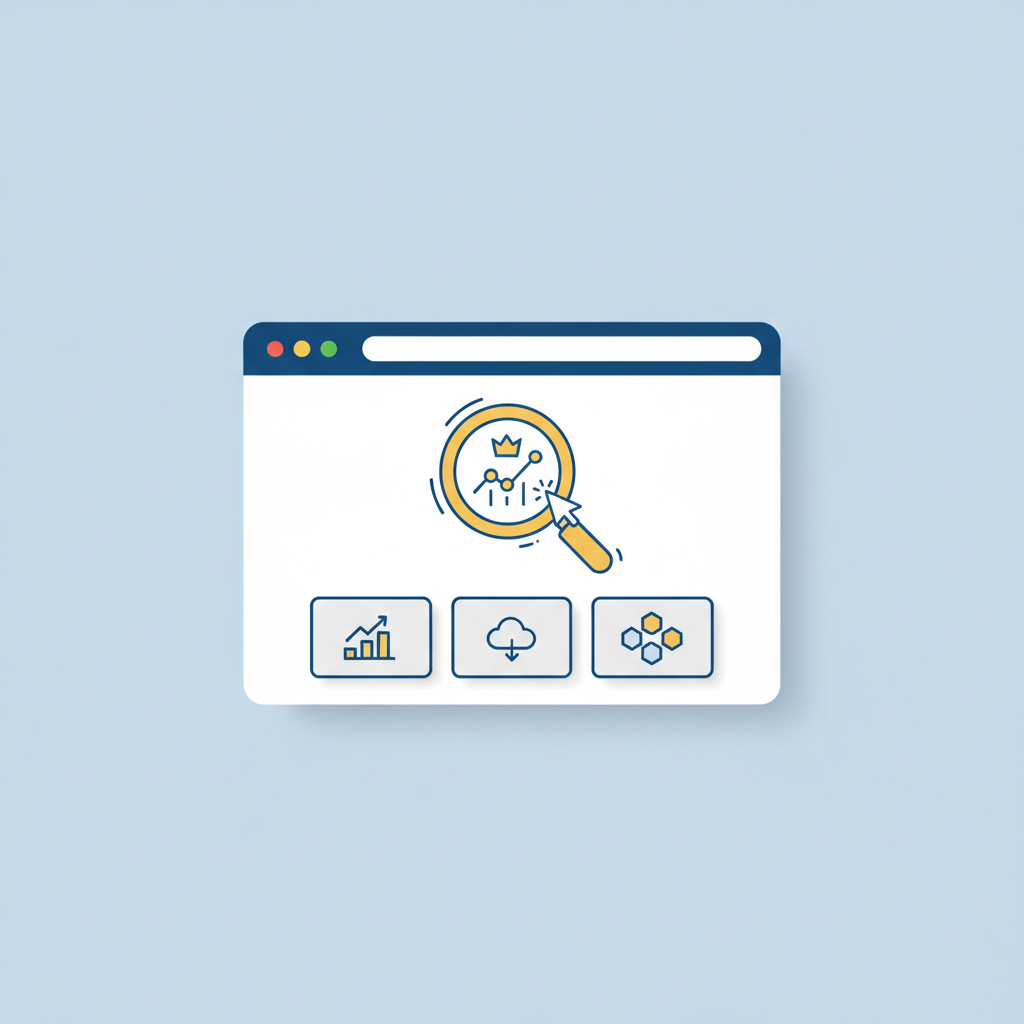Introduction: Beyond the Blog Post – Building a Content Strategy That Drives Growth
Have you ever spent hours, or even days, crafting what you thought was the perfect blog post, only to publish it and hear nothing but crickets? You’re not alone. Many businesses fall into the trap of creating content without a clear purpose, a phenomenon often called ‘random acts of content.’ This approach feels productive, but it rarely leads to tangible results like increased traffic, qualified leads, or sales. The problem isn’t a lack of effort; it’s a lack of strategy. The bridge between creating content and achieving business goals is a documented content strategy, and the foundational pillar of that bridge is effective keyword research.
Keyword research is more than just finding terms people search for; it’s about understanding the language of your audience, decoding their intent, and strategically positioning your content to meet their needs. It’s the difference between shouting into the void and having a meaningful conversation with potential customers. This comprehensive guide will walk you through a step-by-step process to build a robust content strategy from the ground up, with keyword research at its core. We will cover everything from setting goals and analyzing competitors to structuring your team, budgeting for success, and, most importantly, measuring your return on investment.
What Is Keyword Research? (And Why It’s Non-Negotiable)
At its heart, keyword research is the process of discovering the words and phrases people use to search for information, products, and services in search engines like Google. It’s about uncovering not just what people are searching for, but also why they are searching for it. This understanding of user intent is the secret sauce of modern SEO.
A common point of confusion for beginners is the difference between strategy, tactics, and a plan. Let’s clarify this in the context of keyword research:
- Strategy (The Why): This is your high-level vision. Your keyword strategy defines why you are targeting certain topics and audiences. For example, “Our strategy is to become the leading authority for beginners learning about sustainable gardening by targeting informational keywords that address their core challenges.”
- Tactics (The How): These are the specific methods you use to execute your strategy. For example, “Our tactics include creating long-form blog posts for ‘how-to’ keywords, producing short-form videos for ‘what-is’ keywords, and building topic clusters around our core service pages.”
- Plan (The What and When): This is your roadmap, often in the form of a content calendar. For example, “Our plan is to publish a new blog post targeting a specific long-tail keyword every Tuesday and a supporting video every Friday for the next quarter.”
Failing to build your content plan on a foundation of solid keyword research is a recipe for wasted resources. Content marketing is not a field of dreams; if you write it, they won’t necessarily come. You need to build your content on the digital pathways your audience already travels. A documented strategy, driven by data from keyword research, ensures every piece of content you create has a clear purpose and a measurable goal, leading to better team alignment, more predictable growth, and a significantly higher return on investment.
Phase 1: Laying the Foundation – Research and Goal Setting
Before you can find the right keywords, you must first understand what you want to achieve and who you want to reach. This foundational phase is the most critical part of the entire process.
Define Your Business Objectives and Content Goals
Your keyword research efforts should be directly tied to your overarching business objectives. What does your business need to accomplish? Increase revenue by 20%? Generate 500 new marketing qualified leads (MQLs) per quarter?
Once you have your business objective, you can set SMART goals for your content. SMART stands for Specific, Measurable, Achievable, Relevant, and Time-bound.
| SMART Component | Description | Example |
| Specific | Clearly define what you want to accomplish. | We want to increase organic traffic to our new software feature page. |
| Measurable | Define the metric you will use to track progress. | We will measure success by tracking organic sessions and keyword rankings for the feature. |
| Achievable | Set a realistic goal based on your resources and baseline. | Our goal is to increase organic traffic to this page from 100 to 500 sessions per month. |
| Relevant | Ensure the goal aligns with your broader business objectives. | This traffic will support our business goal of increasing free trial sign-ups. |
| Time-bound | Set a deadline for achieving the goal. | We aim to achieve this within the next six months. |
Export to Sheets
Develop Detailed Audience Personas
You cannot find the right keywords if you don’t know who you’re trying to reach. An audience persona is a semi-fictional representation of your ideal customer based on market research and real data.
Consider these questions to build your persona:
- Demographics: What is their age, location, job title, and income level?
- Pain Points: What are their biggest professional or personal challenges that your product or service can solve?
- Motivations: What are their goals and aspirations? What drives their decisions?
- Watering Holes: Where do they spend their time online? Are they on LinkedIn, Reddit, specific forums, or industry blogs?
- Search Behavior: How do they search for information? Do they use technical jargon or simple questions? Do they prefer video or written content?
Understanding these details allows you to step into their shoes and brainstorm keywords they would actually use.
Conduct a Thorough Competitor Content Analysis
A goldmine of keyword ideas is hiding in plain sight: your competitors’ websites. Analyzing what’s already working for them can save you hundreds of hours of guesswork.
Here’s a simple process:
- Identify Your True SEO Competitors: These are any website or entity that ranks for the keywords you want to target, not just your direct business competitors.
- Analyze Their Top Pages: Use SEO tools to find which of their pages receive the most organic traffic.
- Uncover Their Top Keywords: Dig into the specific keywords that are driving traffic to those top pages. Pay attention to the mix of short, high-volume keywords and longer, more specific long-tail keywords.
- Identify Content Gaps: Look for valuable keywords your competitors rank for that you haven’t targeted yet.
- Find Keyword Gaps: Look for relevant keywords that none of your competitors are effectively targeting.
Phase 2: The Blueprint – Content Planning and Creation
With your foundational research complete, it’s time to build the blueprint for your content. This phase translates your keyword list into a structured, actionable content plan.
Identify Your Core Content Pillars
A strategic approach is to use the topic cluster model. This involves identifying 3-5 broad topics, or “pillars,” that are central to your business and expertise.
- Each pillar is represented by a comprehensive “pillar page” that provides a broad overview of the topic.
- This page then links out to more specific “cluster content” (like blog posts) that target long-tail keywords related to the pillar.
This structure signals to Google that you have deep expertise on the topic, helping you rank for both broad and specific terms.
Map Content to the Buyer’s Journey
The intent behind a search query tells you where a user is in their purchasing process, often called the buyer’s journey.
| Stage | User Goal | Keyword Intent | Content Examples |
| Awareness | The user has a problem but doesn’t know the solution. | Informational (how, what, why, guide, tips) | Blog Posts, How-To Guides, Ebooks, Infographics, Checklists |
| Consideration | The user is researching and comparing potential solutions. | Commercial (best, vs, review, comparison, alternative) | Product Comparison Pages, Case Studies, Webinars, In-depth Reviews |
| Decision | The user is ready to buy. | Transactional (buy, price, discount, quote, trial) | Product Pages, Free Trial Sign-ups, Demo Pages, Pricing Pages |
Export to Sheets
Matching keyword intent to the buyer’s journey ensures you’re providing the right information at the right time.
Choose the Right Content Formats
The best format for your content often depends on the keyword itself. The goal is to match the format to the user’s intent and preferences, a process called “search intent analysis.”
- “How to install a smart thermostat”: Requires a step-by-step blog post or a video tutorial.
- “Project management software comparison”: Suggests a detailed comparison table or a long-form review article.
- “Latest digital marketing trends”: Perfect for an infographic, a webinar, or an expert roundup blog post.
Phase 3: Unlocking Hidden Value – Auditing and Repurposing Existing Content
Your existing content is a valuable asset. A content audit helps you identify what’s working, what’s not, and how you can leverage your best pieces for even greater results.
How to Perform a Content Audit
- Create a Content Inventory: Start a spreadsheet of all your content URLs.
- Gather Key Metrics: Pull in important data from Google Analytics and Google Search Console, including organic traffic, keyword rankings, impressions, and conversions.
- Analyze and Categorize: Assign each piece to one of three categories:
- Keep: Performing well. Monitor performance.
- Update: Has potential but is underperforming (outdated, wrong keywords, low CTR). Refresh it with new information and optimize.
- Remove: Irrelevant, low-quality, and receives little to no traffic. Delete these pages and redirect the URL (301 redirect) to a more relevant page to consolidate link equity.
The Art of Content Repurposing
Content repurposing is taking one asset and transforming it into multiple different formats to reach a wider audience. Your content audit will reveal your top-performing pieces—these are the perfect candidates for repurposing.
Here are some actionable examples:
- Blog Post to Video: Turn a popular guide into an engaging YouTube video script.
- Webinar to Blog Series: Break down a one-hour webinar into several in-depth blog posts.
- Case Study to Infographic: Visualize key stats from a successful case study into a shareable infographic.
- Guide to Email Course: Convert a comprehensive guide into a multi-day email course to capture leads.
- Blog Post to Social Media Snippets: Extract key quotes, statistics, and tips to create dozens of social media updates.
Phase 4: Gaining Traction – A Robust Distribution and Promotion Strategy
Creating great, keyword-optimized content is only half the battle. The other half is making sure people see it. A proactive distribution and promotion strategy is essential to build the authority and backlinks needed to rank for your target keywords.
The POEM Framework: Paid, Owned, and Earned Media
The POEM framework helps structure your distribution:
- Paid Media: When you pay to promote your content (e.g., PPC ads on Google, sponsored social media posts). Great for guaranteed visibility and initial traction.
- Owned Media: Channels you control (e.g., your company blog, email newsletter, social media profiles, YouTube channel). The foundation of your distribution efforts.
- Earned Media: When other people share your content for free (e.g., backlinks, mentions in industry publications, organic social shares). The most valuable form of distribution because it acts as a third-party endorsement.
Advanced Promotion Tactics
- Targeted Email Outreach: Identify influencers, journalists, and bloggers who have previously written about your keywords. Send them a personalized email about your new content, focusing on building a relationship, not just asking for a link.
- Content Syndication: Publish your content on larger platforms like Medium or LinkedIn Articles. Be sure to use a canonical tag to point back to the original article on your website.
- Build Strategic Partnerships: Collaborate with non-competing businesses that serve a similar audience for cross-promotion.
- Community Engagement: Find online communities (like Reddit subreddits or Facebook groups) and share your content when it’s genuinely relevant and helpful.
Phase 5: The Content Engine – Structuring Your Team, Tech, and Workflow
An effective keyword research and content strategy requires a well-oiled machine to execute it consistently.
Building Your Content Team
- In-House Specialists: Provides the most control and brand alignment (Content Strategist/SEO Manager, Writers, Editor, Designer).
- Freelance Talent: Flexible and cost-effective for specialized skills or fluctuating content needs.
- Agency Partners: Fastest way to scale your efforts, but typically requires a larger budget.
A hybrid model (in-house strategist + freelance creators) is often a great balance of control and flexibility.
Your Essential Content Marketing Tech Stack
| Tool Category | Purpose | Popular Tools (with links) |
| Project Management | To plan your content calendar, assign tasks, and manage workflows. | Asana, Trello, Notion |
| SEO & Keyword Research | To find keywords, analyze competitors, and track rankings. | Ahrefs, Semrush, Moz, Google Keyword Planner |
| Content Creation & AI | To write, edit, and optimize content for quality and readability. | Grammarly, Jasper, ChatGPT |
| Design & Visuals | To create graphics, infographics, and videos. | Canva, Figma, Adobe Photoshop |
| Analytics & Tracking | To measure performance and track progress toward goals. | Google Analytics, Google Search Console, Hotjar |
Export to Sheets
Phase 6: Proving the Value – Budgeting, KPIs, and Measuring ROI
Content marketing is an investment, and you need to be able to prove its value.
How to Set a Realistic Content Marketing Budget
Consider these key cost centers:
- Talent (Salaries/Freelancer Fees): Typically the largest expense (strategists, writers, editors).
- Tools & Technology: Subscriptions for your SEO tools and analytics platforms.
- Paid Promotion: Budget for PPC ads and sponsored social media posts to amplify your content’s reach.
Choosing the Right KPIs for Your Goals
Track metrics that align with your specific business objectives, not just vanity metrics.
- Goal: Brand Awareness
- KPIs: Keyword rankings, organic traffic, impressions, social media reach, backlinks acquired.
- Goal: Lead Generation
- KPIs: Conversion rate (e.g., for ebook downloads), number of new leads generated, MQLs.
- Goal: Sales & Customer Acquisition
- KPIs: Customer attribution (content that influenced a sale), lead-to-customer conversion rate, revenue generated from organic traffic.
These metrics directly tie your keyword-driven content strategy to revenue, which is essential for securing ongoing investment.
Conclusion: Your Strategy is a Living Document
Building a content strategy powered by meticulous keyword research is a transformative process. It moves you from guessing what your audience wants to knowing exactly how to help them, turning your website into a magnet for qualified traffic and leads.
Remember, this strategy is not a ‘set it and forget it’ document. The digital landscape is constantly evolving. Your keyword research and content strategy must be a living, breathing document. Plan to review your goals, audit your content, and refresh your keyword targets at least quarterly to ensure you remain agile and effective.
Don’t let the scope of this process intimidate you. The journey of a thousand miles begins with a single step. Your call to action today is to pick one core service or product and conduct a mini-competitor analysis. Identify just five valuable keywords they rank for that you don’t. This small, actionable step is the beginning of building a content machine that will drive predictable, sustainable growth for years to come.







